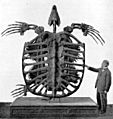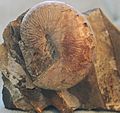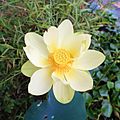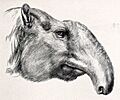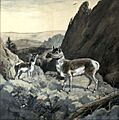List of the prehistoric life of North Dakota facts for kids
This article explores the amazing ancient creatures and plants whose fossils have been found in North Dakota. From tiny sea animals to giant dinosaurs, North Dakota has a rich history of prehistoric life. Scientists study these fossils to learn about Earth's past and how life has changed over millions of years.
Ancient Life in North Dakota
The Precambrian Era: Earth's Earliest Times
The Paleobiology Database shows that no fossils from the Precambrian era have been found in North Dakota yet. This era was Earth's earliest time, long before complex life forms appeared.
The Paleozoic Era: Age of Ancient Seas
The Paleozoic Era, often called the 'Age of Ancient Life,' lasted from about 541 to 252 million years ago. During this time, North Dakota was covered by warm, shallow seas. This means most of the fossils found are from ocean creatures. The dagger symbol (†) next to a name means the creature is now extinct.
Here are some of the fascinating creatures from North Dakota's Paleozoic seas:
- †Acrotreta – a small, lamp-shaped sea creature.
- †Amphipora – a type of coral that grew in branching shapes.
- †Apatokephalus – an ancient arthropod, possibly related to trilobites.
- †Apheoorthis – another type of brachiopod, like a shelled clam.
- †Arthroclema – a type of bryozoan, which are tiny colonial animals.
- †Ceratopea – a snail-like creature with a horn-shaped shell.
- †Hystricurus – a trilobite, an ancient marine arthropod.
- †Lingulella – a very old type of brachiopod that looked like a tongue.
- †Macluritella – a large, coiled snail.
- †Thamnopora – another type of branching coral.
The Mesozoic Era: Dinosaurs and More
The Mesozoic Era, from about 252 to 66 million years ago, is famous as the 'Age of Dinosaurs.' During this time, North Dakota saw huge changes, from inland seas to lush forests. Many different kinds of life, including dinosaurs, lived here.
Dinosaurs and Other Reptiles
- †Anzu – a bird-like dinosaur with feathers, sometimes called the 'chicken from hell.'
- †Edmontosaurus – a large, duck-billed dinosaur that ate plants.
- †Pachycephalosaurus – a dinosaur known for its thick, dome-shaped skull.
- †Paronychodon – a small, meat-eating dinosaur known mostly from its teeth.
- †Saurornitholestes – a swift, bird-like predator, similar to Velociraptor.
- †Thescelosaurus – a small, plant-eating dinosaur.
- †Torosaurus – a horned dinosaur, similar to Triceratops but with a larger frill.
- †Triceratops – one of the most famous horned dinosaurs, a plant-eater.
- †Troodon – a smart, bird-like dinosaur with large eyes.
- †Tyrannosaurus – the mighty 'king' of the dinosaurs, a huge predator.
- †Archelon – a gigantic sea turtle that swam in the ancient seas.
- †Borealosuchus – an ancient crocodile relative.
- †Champsosaurus – a long-snouted, aquatic reptile that looked like a gharial.
- †Platecarpus – a large, marine reptile called a mosasaur, a top predator in the seas.
- †Thoracosaurus – another ancient crocodile relative.
Ancient Fish and Sharks
- Acipenser – an ancient sturgeon, still alive today.
- Atractosteus – a type of gar fish.
- Carcharias – a type of sand tiger shark.
- †Enchodus – a fish with long, needle-like teeth.
- Lamna – a type of mackerel shark.
- Lepisosteus – another type of gar fish.
- Myliobatis – a type of eagle ray.
- Odontaspis – a type of sand tiger shark.
- †Scapanorhynchus – a goblin shark relative.
- †Squatirhina – an ancient angelshark.
Early Mammals and Other Creatures
- †Aletridelphys – an early marsupial, a mammal that carries its young in a pouch.
- †Alphadon – another small, early marsupial.
- †Cimolodon – a small, rodent-like mammal.
- †Didelphodon – a large, otter-like marsupial relative.
- †Gypsonictops – a small, insect-eating mammal.
- †Meniscoessus – a multi-toothed mammal, one of the earliest groups of mammals.
- †Mesodma – another multi-toothed mammal.
- †Hoploscaphites – a type of ammonite, a shelled creature related to squids.
- Crassostrea – an oyster, still found today.
- Nucula – a small, marine clam.
- Sphaerium – a freshwater clam.
Prehistoric Plants
- †Ampelopsis – an ancient vine, similar to grapevines.
- Azolla – a small, floating fern.
- Cercidiphyllum – a type of tree, similar to the modern Katsura tree.
- Cinnamomum – a plant related to modern cinnamon trees.
- Ficus – a fig tree.
- Ginkgo – a very ancient tree, with fan-shaped leaves, still alive today.
- Glyptostrobus – a type of cypress tree.
- †Liriodendron – a tulip tree.
- Metasequoia – a redwood tree, also known as dawn redwood.
- †Nelumbo – an ancient lotus plant.
- Populus – a poplar tree.
- Salvinia – a floating fern.
- Taxodium – a cypress tree, like the bald cypress.
- Vitis – a grape vine.
Cenozoic Era: The Rise of Mammals
The Cenozoic Era, from 66 million years ago to today, is known as the 'Age of Mammals.' After the dinosaurs disappeared, mammals grew larger and became more diverse. North Dakota was home to many different mammals, birds, and plants during this time.
Selected Cenozoic Animals of North Dakota
- †Agnotocastor – an ancient beaver.
- †Allognathosuchus – an alligator relative.
- †Archaeocyon – an early dog-like animal.
- †Archaeotherium – a large, pig-like mammal.
- †Brachycrus – an oreodont, a hoofed mammal unique to North America.
- †Borealosuchus – another ancient crocodile relative.
- †Cantius – an early primate, like a small lemur.
- †Coryphodon – a large, plant-eating mammal.
- †Daphoenus – a bear-dog, an extinct carnivore.
- †Diceratherium – an ancient rhinoceros.
- †Dinictis – a false saber-toothed cat.
- †Herpetotherium – an early marsupial.
- †Hesperocyon – another early dog-like animal.
- †Hyracodon – a running rhinoceros.
- †Ischyromys – an early rodent.
- †Leptauchenia – another oreodont.
- †Leptictis – a small, insect-eating mammal.
- †Megalonyx – a giant ground sloth.
- †Mesohippus – an early horse, smaller than modern horses.
- †Metamynodon – a large, aquatic rhinoceros.
- †Miacis – an early carnivore, related to modern cats and dogs.
- †Miohippus – another early horse.
- †Palaeolagus – an ancient rabbit.
- †Peltosaurus – an ancient lizard.
- †Plesiadapis – a very early primate.
- †Poebrotherium – an early camel.
- †Protoceras – a hoofed mammal with horn-like bumps on its head.
- †Ptilodus – another multi-toothed mammal.
- †Saniwa – a large, ancient lizard.
- †Subhyracodon – another ancient rhinoceros.
- †Teilhardina – one of the smallest and earliest primates.
- †Titanoides – a very large, early plant-eating mammal.
- †Trigonias – an early rhinoceros.
- †Wannaganosuchus – another ancient crocodile relative.
Selected Cenozoic Plants of North Dakota
- Acer – a maple tree.
- Azolla – a small, floating fern.
- Betula – a birch tree.
- Carya – a hickory tree.
- Celtis – a hackberry tree.
- Cercidiphyllum – a Katsura tree.
- Corylus – a hazelnut bush.
- Ficus – a fig tree.
- Ginkgo – the ancient ginkgo tree.
- Glyptostrobus – a type of cypress tree.
- Juglans – a walnut tree.
- Metasequoia – the dawn redwood.
- Nelumbo – a lotus plant.
- Pinus – a pine tree.
- Platanus – a sycamore tree.
- Populus – a poplar tree.
- Quercus – an oak tree.
- Salvinia – a floating fern.
- Taxodium – a bald cypress tree.
Images for kids
-
Mounted fossilized skeleton of the Late Cretaceous sea turtle Archelon
-
Life restoration of the Late Cretaceous duck-billed dinosaur Edmontosaurus annectens
-
Fossilized leaf of the Permian-modern tree Ginkgo
-
Foliage and flower of a living Liriodendron tulipifera, or American Tulip-tree
-
A living Nelumbo lotus
-
Fossilized skeleton of the Late Cretaceous dome-headed dinosaur Pachycephalosaurus
-
Life restoration of the Late Cretaceous herbivorous dinosaur Thescelosaurus
-
Fossilized skeleton of the Late Cretaceous tyrannosaur Tyrannosaurus
-
A living Corylus, or hazel
-
A living Nelumbo lotus
-
Life restoration of a female (left) and male of the Oligocene-Miocene even-toed ungulate Protoceras. Charles R. Knight (1896).




